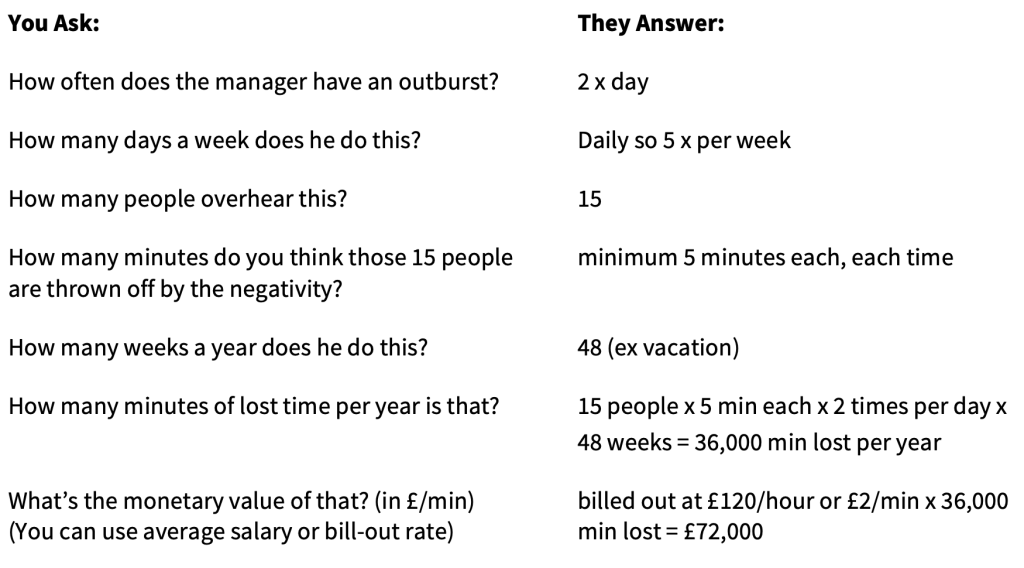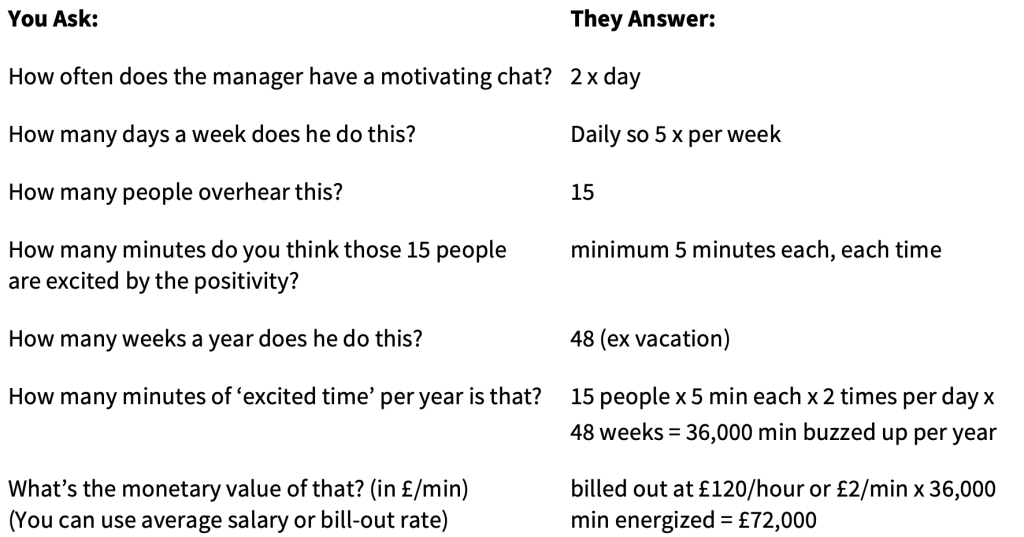Do you ever struggle to get managers to slow down and spend more time with their people? To focus beyond just the task that needs to be done? To engage and develop their teams more while driving for the results?
One way to motivate leaders to spend time on soft skills is to demonstrate the financial impact of effective human interactions. Sometimes when I’m coaching executives, they say, “I don’t have time and, anyway, people skills aren’t a line item on the P&L.” They need justification for spending the time – YOU can give them that hard, tangible rationale by putting a monetary figure on soft skills. YOU can show them how soft skills appear on the P&L to motivate them to spend the time on creating more effective working interactions. Of note, you don’t need to be a mathematician.
How to monetize soft skills
Let’s start with the easier example of putting a monetary value to poor people skills. Imagine you have a manager who is a bit hot-headed and regularly admonishes a different member of staff. Let’s say the manager would have a ‘terse word’ with a member of his staff twice a day. This happened pretty much every day for the 48 weeks he was in the office (I’ve heard one experience where a stern reprimand was messaged while the manager was on holiday). There were 15 people that worked in the open place office. Now, what is the cost of that disruption to the individual, the others witnessing it? You can put time and money into the scenario to demonstrate the cost. I had this scenario with a coaching client where the staffed were billed out at £120/hour. You could use average salaries for the people involved if they aren’t in positions of being billed out to clients.
What do you do as HR?
Sit down with your colleague – it might be the person exhibiting poor people skills, or it might be their boss depending on the situation. Have a piece of paper, pencil, and calculator handy (or device, but you want to make sure they can see the calculation as you go through it). Ask the colleague the following questions, so they guide you through the calculation of how much poor people skills are costing them. You are just prompting their thinking and recording their account of the situation. You are the facilitator, and they are the data providers. You’re not making it up, just recording what they are saying, hence why you want them to see the calculation as you go. Using some of the facts in the scenario we imagined above here is how the exercise of monetizing soft skills would unfold:

If you wanted to be conservative, you could discount it by 50%, so £36,000 per year in lost productivity. This calculation doesn’t take into account any lost time of the staff members meeting at the coffee station and complaining about the manager.
Once you’ve walked them through the financial impact of the poor people skills, ask them, “is saving £36,000 in productivity worth changing your behavior?” If you are talking to their boss, ask, “is saving £36,000 in productivity worth having a conversation with your direct report about their people skills?”
This example illustrates the tangible cost of poor people skills. This estimate doesn’t take into account the gains in the team’s time to do more work or better drive the strategy. That would all be upside.
Monetizing positive people skills
The above was an easier example where you have obvious poor people skills. It’s harder, but not impossible, to quantify the increase in productivity of good or excellent people skills. You could go through similar questions. The key is to have the manager estimate as you ask the question and write down the number. You want it to be their hypothesis; all you are doing is drawing it out of them and showing them a monetary value at the end that they ultimately created. The questions are essentially the same, just replacing the berating with motivating. And rather than lost time, it’s productivity increases, energized time.

The positive example is a bit harder to quantify in a way, as demotivation is so much easier to see, estimate, and quantify. And it is still thought-provoking about how interaction, motivation, and positively influencing others can create value in emotions and money.
The space in between
The incidences of berating managers are few for the executive coaching clients with whom I work. The incidences of consistently inspiring and empathetic managers are few too. The majority of managers fall between the two, the category of neutrality, not knowing how to engage and motivate their teams profoundly. The big opportunity to impact the bottom-line is not the berating manager. Instead, it’s the managers who simply do nothing in terms of soft skills because they don’t’ know what to do.
So what?
This exercise is less about the accuracy of the numbers, although creating a monetary amount does entice many managers. It’s more about the discussion and reflection on how interacting with team members in different ways can hinder or foster productivity. It’s more about the buy-in that negative skills result in a downward spiral. Doing nothing in terms of engaging people does just that, nothing. And positive people skills create upward energy. YOU are creating some space for a manager to think about their impact on the team, the financial impact of behaviors even if it’s only ‘guestimates’ and to question whether they are as effective as they can be.
At the same time, YOU are demonstrating positive people skills in your interaction with the leader – you are adapting your language and mindset to their frame of reference. You are listening, questioning, putting yourself in their shoes by focusing on their financial deliverable.
Soft skills can deliver tangible results.
